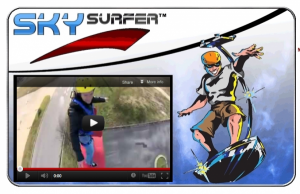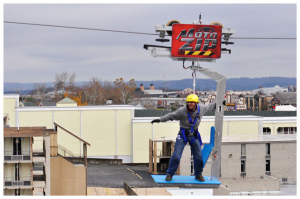Flying High On a Motorized Zip Line
This isn’t your ordinary zip line. SkySurfer is a zip line and roller coaster combined into one. People ride SkySurfer standing, sitting, or laying flat on one of three open-air carts, without cages or handrails, as it goes up and down around the nearly one-mile cable through the urban and wooded area. Two other adventurers are also going along the rollercoaster-zip line hybrid on their own separate carts, with the three moving simultaneously at different spots on the course. This requires the utmost safety measures to be in place.
Before people were able to experience this thrill ride, it had to pass several tests. One of the tests required each slave Programmable Logic Controller (PLC) on the three carts to communicate with the Allen-Bradley® MicroLogix™ 1100 master PLC on the flight deck. The master PLC has an HMI connected to it so an operator can start a cart and monitor data.
The Problem
The original wireless radio communication system that was installed to communicate the distance between the carts wasn’t working properly. There was a 40-second delay in data reception, which is an eternity when it comes to safety. The main purpose for the wireless system is collision avoidance.
Each cart has an encoder on it, which tells how far along the cart is on the track based on each time the wheel spins. Each slave PLC is doing the math and the radio is supposed to send the encoder signal to the master PLC, which can tell the cart to slow down if it gets too close to another cart. The original radio communication system wasn’t performing its job.
Project Manager Jared Story spent months trying just about everything he could to get his original radio communication system to work. He originally thought it was a software issue. It wasn’t. Story wanted to open in time for the holiday crowds. Time was running short. It was early November and Story still couldn’t get his original wireless radio system to work.
Technical support from the original radio system company was non-existent. Their excuse for not sending out technical support was that Story didn’t buy the radios directly from them. “They refused to help me. It didn’t make me happy,” he said.
The Solution
Story heard about ProSoft Technology through an engineer who had used ProSoft solutions. He then contacted an automation distributor in Springfield, Mo. Its field representative suggested he contact ProSoft Technology.
The solution was ProSoft Technology’s 900 MHz Industrial Frequency Hopping Ethernet radios. One was installed on each of the three carts, with one at the Master PLC.
Eric Lockman, a Wireless Support Engineer from ProSoft Technology, received a call on Nov. 4 and performed onsite support only a few days later. Lockman had the ProSoft Technology Frequency Hopping Ethernet radios performing the job in a mere four hours.
Once Lockman arrived, he performed a site analysis and installed three ProSoft radios. A ping test showed there was connectivity all the way around the track, as Lockman and the SkySurfer crew sent the carts off along the course. Lockman had received satellite views of the area a few days before.
“There was full signal all the way around,” Lockman said. And that was with only a small gain antenna. “Even with the small gain antenna, it did well.”
Story bought the radios from the distributor, SMC Electric, that day.
Learn more about ProSoft Technology’s Wireless Solutions here.




